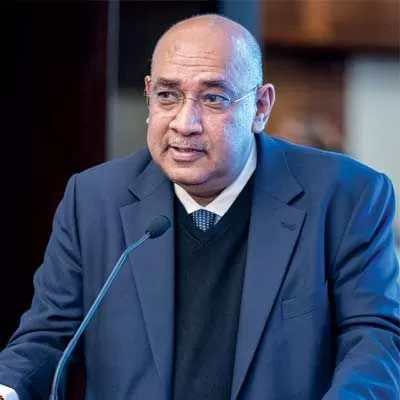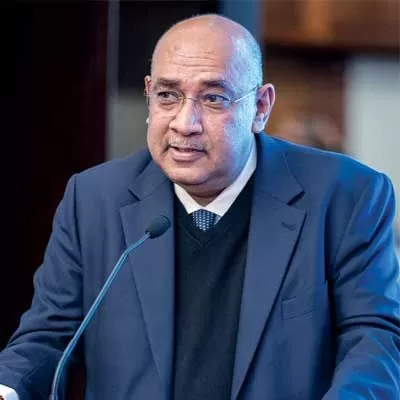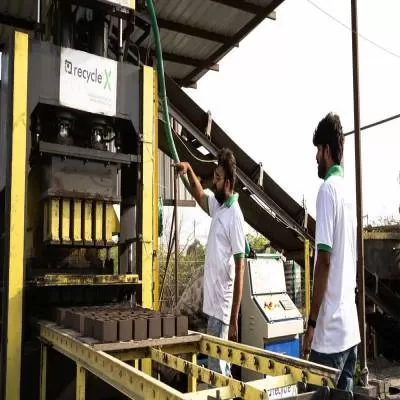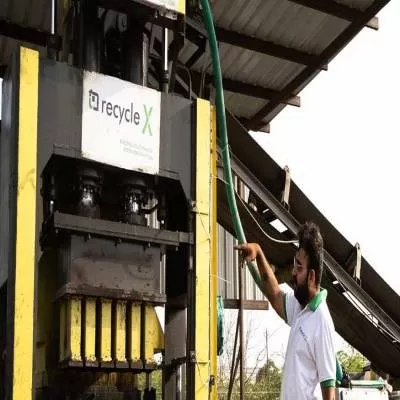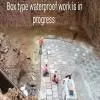- Home
- Infrastructure Urban
- ECONOMY & POLICY
- Land acquisition and big projects are the only way forward
Land acquisition and big projects are the only way forward
This company has the heart and soul – as well as steel – that characterise every survivor. Despite the many challenges it has faced, Ansal API, which has clocked over four decades in the real-estate business, has achieved many firsts to its credit: venturing overseas, launching integrated townships in Tier-II and -III cities, and introducing the mall culture in India through Ansal Plaza. And, recently, its vision of providing advanced quality education to students, with a futuristic approach drawn from across the world was rewarded when Ansal University was given the status of a university on May 16, 2012.
Spearheading the company today is Pranav Ansal, Executive Director, Vice Chairman and Managing Director, who is determined to take the company to new heights. The guiding force behind Ansal API's expansion into township development and commercial set-ups with international standards, Ansal discusses the company and the industry in conversation with Shanti Padukone.
How has the real-estate scenario changed from 1967 to date?
Way back in the 1960s, the realty sector lacked today's level of professionalism; moreover, there wasn't any governing body. However, with many big industrial houses stepping up today, the sector is much more credible. Despite being one of India's most unstructured sectors, it is one of the most important in providing employment next only to agriculture. However, we are still governed by archaic laws that need an immediate overhaul. We must also be granted 'industry' status.
You have been successful in introducing new sets of people to a certain lifestyle...
We introduced this concept to Tier-II and -III cities to decongest metros and provide planned development to smaller towns and cities. The aim is to spruce up the lifestyle here by creating a composite setting. Our upcoming ultra modern townships
in Mohali, Ludhiana, Jalandhar, Jodhpur, Ajmer, Sonepat, Panipat, Karnal, Agra, Kurukshetra, Meerut, etc, will be equipped with medical, commercial, retail, schooling, housing and other core institutions.
Do your strategic alliances with architects and consultants from abroad raise the cost of homes?
While Europe and the US are still in the midst of a slowdown, India's real-estate market is booming; hence, these professionals are eyeing opportunities here. Our international alliances make up 70 per cent of our architects, and there
is no question of a rise in cost as architects get only half to 1 per cent of the total project cost. Moreover, Indian homes have gone straight from hutments to high-end structures. Today, the customer is well-informed and wants an international look and superior quality product.
For instance, our association with Martin Grant Hawtree goes way back. The Hawtree name is synonymous with golf course design since 1912, and Martin has designed an international standard, 18-hole championship golf course in Sushant Golf City, Lucknow. When a name like Hawtree is associated with a project, one is sure to get state-of-the-art architecture and facilities.
Tell us about Sushant Golf City.
Sushant Golf City is India's first hi-tech township sprawling across 3,530 acre. The Golf Habitat is spread over 380 acre, and nine holes of the 18-hole golf course are already operational. The habitat also has five group housing societies like Golf Gateway Tower and four others, which offer a panoramic view. Our recently launched Golf Villas are one of the premium offerings here. We are building 250 such villas on the habitat in five different types designed by New Zealand-based architect Feng Zhan. These are equipped with a fully integrated home automation system that can be controlled from any corner of a city, country or world.
How viable is developing such a project in a Tier-II city?
Today, 50 per cent of our business is in Delhi-NCR, and the rest is in Tier-II and -III cities. Sushant Golf City is in Uttar Pradesh, a state that comprises 24 per cent of India's population. And, Lucknow, being given the status of a Tier-II city, is not exactly small; the volume we are generating is better than that in the NCR. In fact, the aspiration here to buy high quality homes is fantastic. Such cities definitely have a great market, immense potential and are undoubtedly more profitable than Tier-I cities.
You are also training local people and landowners to add skills to the development of this township. Has this initiative smoothened land acquisition?
It is a myth that old cities don't want to change and revel in their quaintness. Locals also aspire for a better life and want to be part of the mainstream. As a realty company, we have felt the need to convince them about the life they can and should lead. Hence, in Sushant Golf City, we have adopted around 30 villages and are improving their infrastructure and training the villagers to add skills to the development. This has helped us smoothen land acquisition activities in the bargain and build a long-term relationship with farmers by giving them the opportunity to be future stakeholders of the company.
How is the government addressing this? And, how does Ansal API contribute to affordable housing?
If the government was addressing this issue, India would never face the problem of affordable housing. With land acquisition issues, land prices have shot up, and the government is not able to provide affordable homes. As part of our projects, 5 per cent of land is mandatorily reserved for homes for the economically weak. Of our total land bank, 450 acre will be developed for affordable housing. This is a government statutory approval with only a certain prescribed area and poor certifications. In fact, even the new bills constantly being passed are contrary to the view of providing these. Our effort is to add more value with better specifications and homes. But, in my view, the government is doing practically nothing!
Last year, the government had announced a housing shortage of about 25 million…
In fact, this figure is increasing every year! Five years ago, it was 22 million, which only goes to show that all the builders put together – private and public – are not able to meet the rising demand. This can be attributed only to bureaucracy and non-computerised land records existing since the British era. It takes almost a month to dig out titles of land to be bought, with the 70-year-old rules that have to be followed! We need digitised land records for transparency and ease of way.
Also, there is no escape from the lack of single-window clearances...
As developers and through CREDAI, we have addressed this subject time and again. In fact, this is one of the main reasons for rising real-estate prices and project delays. Ultimately, the customers suffer by paying a price that is much higher.
Nowadays, project delays are easily attributed to the builder, but it is the government that has no accountability in giving approvals. It's as simple as giving or rejecting it, not sleeping on it for years! For any kind of real-estate revolution in the country, this is the first thing that should be changed. We recently submitted a complete proposal to the Ministry of Urban Development and Ministry of Housing and Urban Poverty Alleviation on developing an online process that is applicable globally. Here, each approval has timelines for both parties, maintaining complete transparency. Such a process also makes the
customer more aware. We hope for a positive response.
What is your current land bank? How do you work around site selection?
Our current land bank of 9,000 acre is spread across four states in north India: Punjab, Haryana, Rajasthan and Uttar Pradesh. Under construction in various stages, some of these projects are already operational. We cater to almost 40 per cent of the Indian population, with the South being untouched. We choose our site depending on proposed usage, but land selection is not really a matter of choice. Every city has its master plan and, most often, we have to make do with land parcels from a limited choice, given the extreme competition today.
How do you view the future of the Indian real-estate industry?
Mega townships are the future of India. In north India, especially, a lower floor-area ratio prevents us from building high rises; hence, developers go horizontal for which we need large land parcels. The government and developers should work together to achieve this. Also, the primary objective should be to create energy and water-efficient, comfortable, healthy and environment-friendly buildings and homes. And, with the major influx of population from rural to urban areas, land acquisition and big projects are the only way forward.
Fact Sheet:
Year of Establishment: 1967
Top Management (Promoters): Sushil Ansal, Executive Director & Chairman; Pranav Ansal, Executive Director, Vice Chairman and Managing Director.
Centre(s) of Operation: Haryana, Punjab, Greater Noida, Rajasthan, Uttar Pradesh
Ongoing Projects: Esencia, Megapolis, Sushant Golf City, Aquapolis
Turnover for 2011: (consolidated): Rs 12,357.7 million
Know of a builder who made it big in the industry? Write in at feedback@ASAPPmedia.com
Pranav Ansal, Executive Director, Vice Chairman and Managing Director, Ansal APIThis company has the heart and soul – as well as steel – that characterise every survivor. Despite the many challenges it has faced, Ansal API, which has clocked over four decades in the real-estate business, has achieved many firsts to its credit: venturing overseas, launching integrated townships in Tier-II and -III cities, and introducing the mall culture in India through Ansal Plaza. And, recently, its vision of providing advanced quality education to students, with a futuristic approach drawn from across the world was rewarded when Ansal University was given the status of a university on May 16, 2012.Spearheading the company today is Pranav Ansal, Executive Director, Vice Chairman and Managing Director, who is determined to take the company to new heights. The guiding force behind Ansal API's expansion into township development and commercial set-ups with international standards, Ansal discusses the company and the industry in conversation with Shanti Padukone.How has the real-estate scenario changed from 1967 to date?Way back in the 1960s, the realty sector lacked today's level of professionalism; moreover, there wasn't any governing body. However, with many big industrial houses stepping up today, the sector is much more credible. Despite being one of India's most unstructured sectors, it is one of the most important in providing employment next only to agriculture. However, we are still governed by archaic laws that need an immediate overhaul. We must also be granted 'industry' status.You have been successful in introducing new sets of people to a certain lifestyle...We introduced this concept to Tier-II and -III cities to decongest metros and provide planned development to smaller towns and cities. The aim is to spruce up the lifestyle here by creating a composite setting. Our upcoming ultra modern townships in Mohali, Ludhiana, Jalandhar, Jodhpur, Ajmer, Sonepat, Panipat, Karnal, Agra, Kurukshetra, Meerut, etc, will be equipped with medical, commercial, retail, schooling, housing and other core institutions.Do your strategic alliances with architects and consultants from abroad raise the cost of homes?While Europe and the US are still in the midst of a slowdown, India's real-estate market is booming; hence, these professionals are eyeing opportunities here. Our international alliances make up 70 per cent of our architects, and there is no question of a rise in cost as architects get only half to 1 per cent of the total project cost. Moreover, Indian homes have gone straight from hutments to high-end structures. Today, the customer is well-informed and wants an international look and superior quality product.For instance, our association with Martin Grant Hawtree goes way back. The Hawtree name is synonymous with golf course design since 1912, and Martin has designed an international standard, 18-hole championship golf course in Sushant Golf City, Lucknow. When a name like Hawtree is associated with a project, one is sure to get state-of-the-art architecture and facilities. Tell us about Sushant Golf City.Sushant Golf City is India's first hi-tech township sprawling across 3,530 acre. The Golf Habitat is spread over 380 acre, and nine holes of the 18-hole golf course are already operational. The habitat also has five group housing societies like Golf Gateway Tower and four others, which offer a panoramic view. Our recently launched Golf Villas are one of the premium offerings here. We are building 250 such villas on the habitat in five different types designed by New Zealand-based architect Feng Zhan. These are equipped with a fully integrated home automation system that can be controlled from any corner of a city, country or world.How viable is developing such a project in a Tier-II city?Today, 50 per cent of our business is in Delhi-NCR, and the rest is in Tier-II and -III cities. Sushant Golf City is in Uttar Pradesh, a state that comprises 24 per cent of India's population. And, Lucknow, being given the status of a Tier-II city, is not exactly small; the volume we are generating is better than that in the NCR. In fact, the aspiration here to buy high quality homes is fantastic. Such cities definitely have a great market, immense potential and are undoubtedly more profitable than Tier-I cities.You are also training local people and landowners to add skills to the development of this township. Has this initiative smoothened land acquisition?It is a myth that old cities don't want to change and revel in their quaintness. Locals also aspire for a better life and want to be part of the mainstream. As a realty company, we have felt the need to convince them about the life they can and should lead. Hence, in Sushant Golf City, we have adopted around 30 villages and are improving their infrastructure and training the villagers to add skills to the development. This has helped us smoothen land acquisition activities in the bargain and build a long-term relationship with farmers by giving them the opportunity to be future stakeholders of the company.How is the government addressing this? And, how does Ansal API contribute to affordable housing?If the government was addressing this issue, India would never face the problem of affordable housing. With land acquisition issues, land prices have shot up, and the government is not able to provide affordable homes. As part of our projects, 5 per cent of land is mandatorily reserved for homes for the economically weak. Of our total land bank, 450 acre will be developed for affordable housing. This is a government statutory approval with only a certain prescribed area and poor certifications. In fact, even the new bills constantly being passed are contrary to the view of providing these. Our effort is to add more value with better specifications and homes. But, in my view, the government is doing practically nothing!Last year, the government had announced a housing shortage of about 25 million…In fact, this figure is increasing every year! Five years ago, it was 22 million, which only goes to show that all the builders put together – private and public – are not able to meet the rising demand. This can be attributed only to bureaucracy and non-computerised land records existing since the British era. It takes almost a month to dig out titles of land to be bought, with the 70-year-old rules that have to be followed! We need digitised land records for transparency and ease of way.Also, there is no escape from the lack of single-window clearances...As developers and through CREDAI, we have addressed this subject time and again. In fact, this is one of the main reasons for rising real-estate prices and project delays. Ultimately, the customers suffer by paying a price that is much higher.Nowadays, project delays are easily attributed to the builder, but it is the government that has no accountability in giving approvals. It's as simple as giving or rejecting it, not sleeping on it for years! For any kind of real-estate revolution in the country, this is the first thing that should be changed. We recently submitted a complete proposal to the Ministry of Urban Development and Ministry of Housing and Urban Poverty Alleviation on developing an online process that is applicable globally. Here, each approval has timelines for both parties, maintaining complete transparency. Such a process also makes the customer more aware. We hope for a positive response.What is your current land bank? How do you work around site selection?Our current land bank of 9,000 acre is spread across four states in north India: Punjab, Haryana, Rajasthan and Uttar Pradesh. Under construction in various stages, some of these projects are already operational. We cater to almost 40 per cent of the Indian population, with the South being untouched. We choose our site depending on proposed usage, but land selection is not really a matter of choice. Every city has its master plan and, most often, we have to make do with land parcels from a limited choice, given the extreme competition today.How do you view the future of the Indian real-estate industry?Mega townships are the future of India. In north India, especially, a lower floor-area ratio prevents us from building high rises; hence, developers go horizontal for which we need large land parcels. The government and developers should work together to achieve this. Also, the primary objective should be to create energy and water-efficient, comfortable, healthy and environment-friendly buildings and homes. And, with the major influx of population from rural to urban areas, land acquisition and big projects are the only way forward.Fact Sheet:Year of Establishment: 1967Top Management (Promoters): Sushil Ansal, Executive Director & Chairman; Pranav Ansal, Executive Director, Vice Chairman and Managing Director.Centre(s) of Operation: Haryana, Punjab, Greater Noida, Rajasthan, Uttar PradeshOngoing Projects: Esencia, Megapolis, Sushant Golf City, AquapolisTurnover for 2011: (consolidated): Rs 12,357.7 millionKnow of a builder who made it big in the industry? Write in at feedback@ASAPPmedia.com


